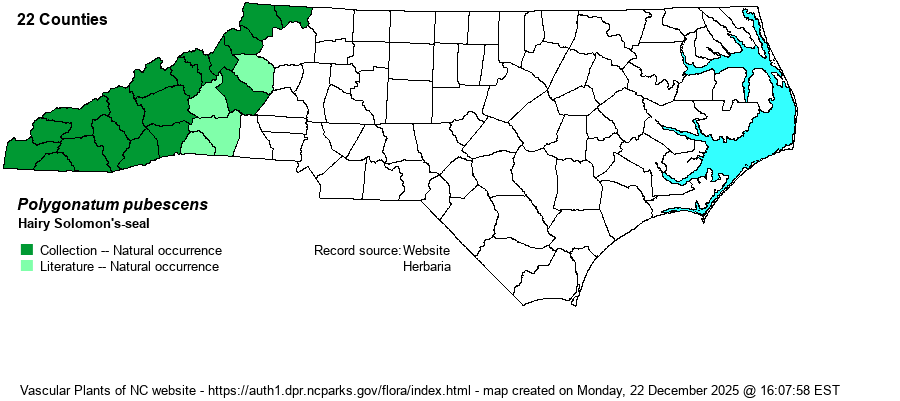| Author | (Willdenow) Pursh | |
| Distribution | Throughout the Mountains, with specimen records from all counties. Does not occur east of the Blue Ridge Escarpment.
This is a Northeastern species, occurring from eastern Canada south to NJ, PA, and IA, and then southward mainly in the Mountains to northern GA and northern AL. | |
| Abundance | Frequent (fairly common to locally common) in most of the Mountains, probably less numerous at the lower elevations. The NC NHP's State Rank of S3 underestimates the abundance level of the species, and the large number of specimens and the fact it has been recorded in all Mountain counties clearly suggest a State Rank of S4. | |
| Habitat | This is a species that is most common in Rich Cove Forests, but it is also fairly widespread in Northern Hardwood Forests, montane oak forests, and less so into Acidic Cove Forests. It often grows in the same places as the similar P. biflorum, which also has been found in all Mountain counties and is a more common species. | |
| Phenology | Blooms from late April into June, and fruits from August into October. | |
| Identification | This is a familiar montane wildflower to botanists, but to the average person it is undoubtedly overlooked as simply being a "Solomon's-seal". It is a smaller species than its congener, having a slender and arching stem usually 1.5-2 feet long at most. It has the same growth form -- numerous, alternate, elliptical leaves arranged in a single plane -- and small whitish flowers dangling from the leaf axils. In this species, however, there are mainly just 1-2 flowers at an axil as opposed to often 4-6 flowers, and the leaf undersides have clearly pubescent veins. Thus, if you see a small Solomon's-seal, especially one that is in bloom, that is barely 1.5-2 feet long, it might be this species, as most individuals of S. biflorum in that province when in bloom are often 3-4 feet long. Always flip a leaf over and check for pubescence on the undersides, as P. biflorum is smooth on the undersides. You may need to bend a leaf and hold it up to the sky or to a black background to be able to see the abundant hairs. Sadly, this wildflower gets little or no respect, as it is usually overlooked as its "big brother"; if you are paying attention to look for it on mountain walks in rich or moist hardwood forests, you can often find it. | |
| Taxonomic Comments | None
| |
| Other Common Name(s) | Downy Solomon's-seal | |
| State Rank | S3 [S4] | |
| Global Rank | G5 | |
| State Status | | |
| US Status | | |
| USACE-agcp | FACU link |
| USACE-emp | FACU link |

